An Analysis of the Effects of Volatile Organic Compound (Odour Emissions) from Municipal Solid Waste Dumps on the Environment and Quality of Life
1
Department of Civil Engineering,
Aarupadai Veedu Institute of Technology,
Vinayaka Missions Research Foundation (VMRF-DU),
Paiyanoor, Chennai,
Tamil Nadu
India
Corresponding author Email: divahar.civil@avit.ac.in
Copy the following to cite this article:
Srinivasan S, Divahar R. An Analysis of the Effects of Volatile Organic Compound (Odour Emissions) from Municipal Solid Waste Dumps on the Environment and Quality of Life. Curr World Environ 2025;20(1).
Copy the following to cite this URL:
Srinivasan S, Divahar R. An Analysis of the Effects of Volatile Organic Compound (Odour Emissions) from Municipal Solid Waste Dumps on the Environment and Quality of Life. Curr World Environ 2025;20(1).
Citation Manager Publish History
Select type of program for download
| Endnote EndNote format (Mac & Win) | |
| Reference Manager Ris format (Win only) | |
| Procite Ris format (Win only) | |
| Medlars Format | |
| RefWorks Format RefWorks format (Mac & Win) | |
| BibTex Format BibTex format (Mac & Win) |
Article Publishing History
| Received: | 2024-09-23 |
|---|---|
| Accepted: | 2025-03-24 |
| Reviewed by: | 
 Atun Roy Choudhury
Atun Roy Choudhury
|
| Second Review by: |

 Shyamala Mani
Shyamala Mani
|
| Final Approval by: | Dr. R K Aggarwal |
Introduction
A rising population is contributing to the rapid growth of cities. In both urban and rural areas, solid waste grew daily. The development of cities and population expansion are the main causes of the annual rise in MSW results, according to global economic development. The World Bank estimated that the quantity of MSW generated in 2020 globally was 2.24 billion tons, and by 2050, that amount was expected to to 3.88 billion tons.1,2 Size, age, moisture content, and physical characteristics (such the solid waste's density) are some of the factors that contribute to odour emissions at the disposal sites. Currently available data indicates that 80–90% of MSW is disposed of in dumps without any kind of treatment. When solid waste is not separated, it impacts the air and releases odours, which is a nuisance to the environment.3 The different waste materials and its ages that are present in the dumping yard easily generate odour emissions due to biological and chemical processes, mostly supported by weather-related conditions.4 Figure 1 indicates the global solid waste composition of waste at the dumping yard.5 Ammonia and methane, two gasses that cause odours, are released by the sanitary landfill. According to current data, the planned gas collecting system has detected levels of volatile organic compounds, carbon dioxide, and methane.6 MSW sources such as waste incineration, composting yards, street dust bins, and dumbping yards all contribute to complex odour emissions. When waste enters a dumping yard, it accelerates the process of microbial breakdown, which can eventually go from aerobic to anaerobic degradation, depending on how the dumping yard is used.7 During collection, transportation, and transfer, waste is exposed to a primarily aerobic environment, which causes the organic substance inside it to breakdown. Anaerobic biodegradation, which begins and goes through three stages before stabilization: acetogenesis, methanogenesis, and cidogenesis, efficiently degrades 44%.MSW, is a huge environmental issue, particularly in developing nations, where it contributes to greenhouse gas emissions from landfills as well as pollution of the air, water, soil, and odour.
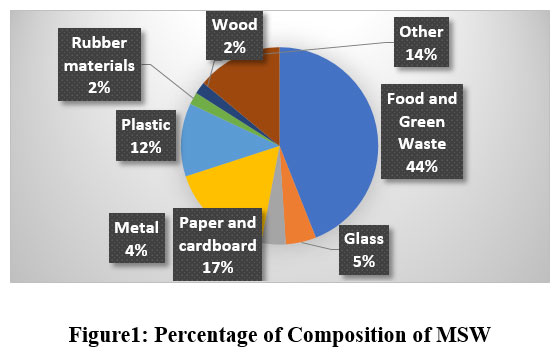 | Figure 1: Percentage of Composition of MSW
|
Improper solid waste management has various harmful consequences. Diseases spread as a result of improper disposal of waste, which commonly contaminates land and water resources. In developing nations like India, where 90% of wastes is disposed of inappropriately, especially in larger cities and towns, unscientific disposal techniques are common.8-9 Extended exposure to these malodorous substances has been linked to odour-related problems and potential health concerns. These issues include physical symptoms such as nausea, eye irritation, and respiratory discomfort. Moreover, individuals may experience psychological stress due to this exposure.10
Odour emissions from municipal solid waste, which covers a different waste category such has fresh, moderate and tywere investigated on fresh MSW wastes to determine the concentrations levels of different odours compounds and its family groups.
The primary goal of the investigation was:
To determine the consequence of odour exposure for public health.
To determine the consequence of odour exposure forom MSW Dumping yard on the surrounding environment (quality of life).
Significance of Research on Odour Emissions
Several attempts have been made to segregations of MSW, however open dump disposal and dumping yard treatment have not been completely handled. This is one of the most common causes for odour emissions from open landfills.4 Odour is one of the primary concerns of residents who live near the dumping yard.11 This investigation describes an in-depth analysis of the odour emissions associated with fresh waste from the MSW dumping yard, with the objective of closing this gap and providing a useful decision-making tool for identifying the various odours - volatile organic compounds, their chemical families, and their impact on the environment, MSW workers and quality of life.
Materials and Methods
Collection of MSW Air Samples
An initial investigation was carried out in the location (semi urban area of Thiruporur, Chennai). Figure 2 represents the process of transporting fresh MSW waste from residential or street bins to an MSW disposal yard and the methodology utilized in the research. The field-based investigation, which sampling instrument used an ADT probe and a BDX II abatement air sampler. Odour samples were collected from three separate locations within the MSW dumping yard a 30-minute sampling interval.
Sampling procedures are derived from Indian standard for method for measurement of air pollution IS5182 PART 11(2006). The samples are collected in glass tube of 7 cm long, 6-mm OD, 4- mm ID, flame-sealed ends, containing two sections of activated coconut shell charcoal (front = 100 mg, back = 50 mg). Break the ends of the sample adsorbent tube immediately before sampling. Attach sampling tube to the personal sampling pump with flexible tubing. Sampling flow rate in the range of 20-100 ml/min is required (±2 percent) for ambient air. Cap the samplers with plastic (not rubber) caps and pack securely for shipment. Sampled tubes shall be capped then stored and transported in an air tight VOC free container without exposure to direct sun light and below 25ºC. The observation took place at an MSW disposal yard adjacent to the one where separate samples of odour were gathered. Using an ADT probe, the air quality within the MSW was continually monitored during the summer season of 2023, during the entire disposal of fresh waste at the dumping yard.
 | Figure 2: Travel of fresh wastes to MSW dumping yard
|
Samples are collected while considering the local climate to monitor the seasonal and geographic movements in ambient air odour. Fresh wastes dumping locations were identified in the dumping yard to gather the samples. The samples were immediately sent to the laboratory for analysis.
Odour Analysis using GC-MS Techniques
Odours are present in ambient air, hence air samples containing them will be collected at different distances from the MSW solid waste dumping yard. A BDX II Abatement Air Sampler pump was used for collecting ambient air containing the odour-causing compounds in the Automated Density Tester Sampling Probe at a flow rate of 0.5–3.0 LPM. The electrical flow control adjustment for the portable BDX II Abatement Air Sampler is built straight into the apparatus. Recharging the battery pack is possible. The ADT Probe, which uses 9.1 cm tubes that are either electronically labelled was used to collect VOC samples. The mouth of the tube was carefully sealed off after the sample is obtained, and the location, date, and time of the sample. This sample tube was sent to the laboratory and the odour concentration was measured.
A gas chromatograph (GC) was used to assess the odour of volatile organic compounds (VOCs). The concentrations were measured using an Agilent 6890 N series GC (Gas Chromatograph system) equipped with a single Flame Ionization Detector (FID) column. There is one 100 psi EPC Spitless Injection Port used to inject the sample at the specified temperature. The GC is equipped with a 17-inch flat panel monitor, a Pentium computer, a 6890 injector, 6890 control electronics, and an autosampler. At the fresh waste sampling locations, air samples were collected using ADT probes. The samples were collected at the fresh solid waste dumping yard. Several volatile organic compounds (VOCs) were analysed in the ambient air that was collected from the landfill.
Statistical Analysis
The mean and standard deviation of 18 different chemicals found in fresh waste at the MSWDYs used for the three monitoring locations, were compared using statistical methods All statistical analyses in this study were carried out using Microsoft Excel.
Results
An investigation of VOC generation and odour emissions in Thiruporur MSWDYs. Iidentified odour compounds at the MSWDYs site and were classified as CFCs, halogenated compounds, and aromatic compounds. Some of the compounds were present at concentrations in the 'below detection level (BDL)' limit. The following information provides more information on the odour emissions at three various locations in the MSWDYs of fresh waste.
VOCs presence in the Monitoring Station: 1
Tables 1, 2, and 3 indicate the presence of different volatile organic compounds, concentrations, average and standard deviation of each sampling location, and also the type of odours from each chemical compound and the boiling temperature of the fresh waste disposed in the dump yards. Apart from methane, hydrogen sulfide, and ammonia, VOCs take major responsibility for emitting the odour emissions in the MSWDYs.
Six predominant forms of odour compounds can be identified, in particular MSWDYs. The six volatile organic compounds represented in figure 3 were found at sampling station 1, and they correspond to the aromatic compound group. The specified temperature range seems to be causing the peaks to split more clearly. The MSWDYs station 1 showed a maximum concentration of 1.41 µg/m3 for tert-butylbenzene and a minimum concentration of 0.07 µg/m3 for sec butylbenzene. An average of 0.37% of the odour emission in station-1 comes from six different volatile organic chemicals belonging to the aromatic chemical group.
Table 1: VOCs Concentrations and Types of Odours
S.No | Chemical Group | VOCs Compounds | Concentrations (µg/m3) | Boiling Point | Type of Odours |
1 | Aromatic Compounds | Secondary - butylbenzene | 0.07 | 173 °C | Pleasant or fruity |
2 | Ortho-xylenes | 0.12 | 143–145°C | Strong or sweet | |
3 | Ethyl benzene | 0.18 | 136 °C | like gasoline | |
4 | Toluene | 0.195 | 110.6 °C | Pungent | |
5 | m & p-xylenes | 0.25 | 139.3°C | Strong | |
6 | tert- butylbenzene | 1.41 | 169 °C | Mothball | |
Average | 0.37 | ||||
Standard Deviation | ±0.51 | ||||
Each volatile organic compound has a sharp boiling point, and different types of odours are present in the MSWDYs depending upon the wind flow and wind speed. Odour emissions easily create consequences for the surroundings as well as for MSW workers. Similarly for all three stations. Our data collection occurred during the summer season, characterized by relatively elevated temperatures and minimal microbial activity. These conditions coincided with mild decomposition, resulting in the highest observed VOC emissions. The results show that the product unit at the dumping yard had quite high VOC emission concentrations, especially aromatic and halogenated chemical compounds. Volatile organic compounds (VOCs) have been created during the biological breakdown of the mixed waste materials in the MSWDYs.12
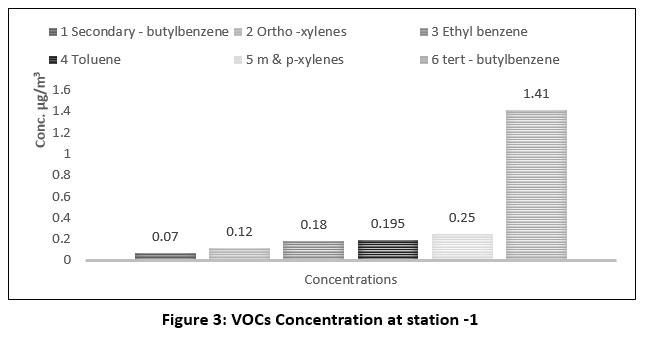 | Figure 3: VOCs Concentration at station -1
|
VOCs presence in the Monitoring Station: 2
The seven volatile organic chemical compounds concentration ranges represented in figure 4 were found in sampling station-2 and correspond to the halogenated, aromatic compounds, and chlorofluorocarbons group of volatile organic compounds. The specified temperature ranges cause the peaks to split more clearly. The MSW dumping yard station 2 showed a maximum concentration of 0.37 µg/m3 for methyl ethyl ketone and a minimum concentration of 0.07 µg/m3 for Sec butylbenzene.13 An average of 0.22% of the odour emission in station-2 comes from seven different volatile organic chemicals belonging to the aromatic, halogenated and chlorofluorocarbons chemical group.
Table 2: VOCs Concentrations and Types of Odour
S.No | Chemical Compounds | VOCs Families | Concentrations (µg/m3) | Boiling Point | Type of Odours |
1 | Aromatic Compounds | Secondary-butylbenzene | 0.07 | 173 °C | Pleasant or fruity |
2 | ortho-xylenes | 0.15 | 143–145°C | Strong or sweet | |
3 | Toluene | 0.2 | 110.6 °C | Pungent | |
4 | Ethyl benzene | 0.23 | 136 °C | like gasoline | |
5 | m&pxylenes | 0.25 | 139.3°C | Strong or sweet | |
6 | Halogenated Compound | Methyl chloride | 0.28 | -24.2 °C | Faint sweet |
7 | Chlorofluorocarbons | Methyl ethyl ketone | 0.37 | - | Slight etherlike |
Average | 0.22 | ||||
Standard Deviation | ±0.08 | ||||
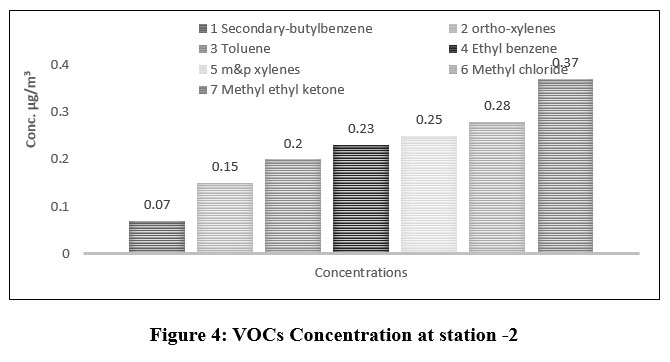 | Figure 4: VOCs Concentration at station -2
|
VOCs presence in the Monitoring Station: 3
The five volatile organic chemical compounds concentration ranges represented in figure 5 were found at sampling station 3 and correspond to the halogenated, aromatic compounds, and chlorofluorocarbons group of volatile organic compounds. The MSW dumping yard station 2 showed a maximum concentration of 1.02 µg/m3 for benzene and a minimum concentration of 0.11 µg/m3 for trichloroethylene. An average of 0.33% of the odour emission in station-3 comes from five different volatile organic chemicals belonging to the aromatic, halogenated and chlorofluorocarbon chemical group.
Table 3: VOCs Concentrations and Types of Odours
S.No | Chemical Compounds | VOCs Families | Concentrations (µg/m3) | Boiling Point | Type of Odours |
1 | Halogenated Compound | Tetrachloroethylene | 0.11 | 121.1 °C | Slight etherlike |
2 | Chlorobenzene | 0.12 | 132 °C | Pleasant | |
3 | Aromatic Compounds | normal-butylbenzene | 0.18 | 183.3 °C | Slightly sweet |
4 | chlorofluorocarbon | Trichloro fluro methane | 0.23 | 23.77 °C | Sweetish |
5 | Aromatic Compounds | Benzene | 1.02 | 80.1 °C | Gasoline |
Average | 0.33 | ||||
Standard Deviation | ±0.39 | ||||
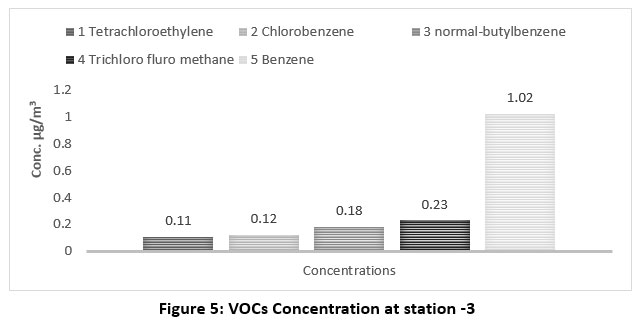 | Figure 7: VOCs Concentration at station -3
|
MSWDYs odour compounds have different kinds of odours, either mildly pleasant or unpleasant. Concentrations are influenced by the kinds of microorganisms found in the waste, waste's age, composition, stage of decomposition, and pace of decomposition. Odorous waste are mostly hazards to occupational health and the environment.14 Meteorological conditions (wind, temperature, pressure, and humidity) play a major role in odours traveling from the MSWDYs boundaries.
Discussion
This research indicates that a semi-urban municipal solid waste disposal site contains various waste types. The study specifically analysed fresh waste ambient air odour samples from three different locations within the dumping area to identify and quantify odorous compounds. The findings from these three sampling sites are compared, and the resulting implications are explored in the following discussion.
Comparison of various odours compounds and concentrations at three stations.
During monitoring of the fresh waste, around eighteen various odour compounds were identified with different concentrations at the landfill dumping yards. An analysis of the composition of odour components at dumping sites is shown in Figure 6. The temperature program specified causes the peaks to appear to separate more precisely in all three stations, although only a few odour components repeat in all three. Collected samples were analysed using GC-MS. Eighteen compounds were detected with three different chemical families. From the three stations, the maximum number of odour compounds were reported in station -1 is tert-butylbenzene at 1.41 µg/m3, and the minimum amount is due to sec-butylbenzene at 0.07 µg/m3. Comparison between stations 1, 2, and 3, station 1 has the presence of these two compounds, which are from aromatic families. The MSW disposal yard contains two substances, sec-butylbenzene and tert-butylbenzene, that individuals can either inhale or consume. The public health consequence of odour exposure of these two compounds due to MSW dumping would be on the surrounding environment, and the quality of life, details of which are mentioned below. This is substantiated through the statistical analysis of the three stations. In station 2, around seven different compounds are identified among three different families of compounds. However, the maximum number of odour compounds reported in station 2 is methyl ethyl ketone at 0.37 µg/m3, which is from the chlorofluorocarbons chemical group, and the minimum amount is toluene at 0.2 µg/m3, which is from the aromatic chemical group. In station -3, around five different compounds are identified among three different families of compounds. However, the maximum number of odour compounds reported in station -3 are benzene at 1.02 µg/m3, which is from the aromatic chemical group, and the minimum amount is due to tetrachloroethene at 0.11 µg/m3, which is from the halogenated chemical group. The presence of these different compounds and their concentration from the fresh waste at the MSW dumping yard during the degradation processes, is due to the type of waste, and metrological factors which play a major role in releasing the odorous compounds.
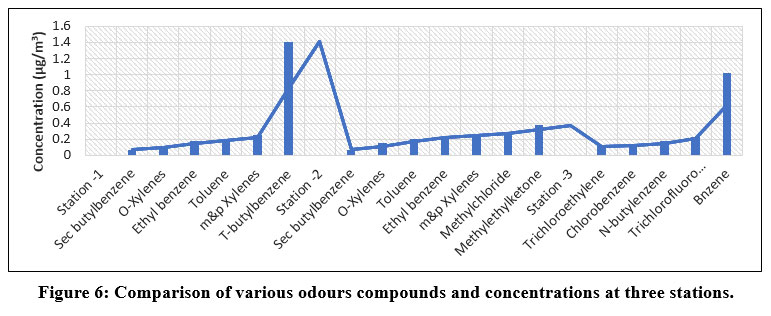 | Figure 6: Comparison of various odours compounds and concentrations at three stations.
|
The statistical analysis employed was the descriptive statistics, such as average and standard deviation, carried out for three sampling stations at the MSW dumping yard. The data was subjected to the comparison of the mean differences between the monitored values. The statistical descriptions for concentrations of the odour emission for three sampling stations are shown in Figure 7. Compared with stations 1, 2, and 3, station 1 has a descriptive statistics average of 0.37 and a standard deviation of 0.51. The presence of aromatic compounds plays a major role in station 1.15
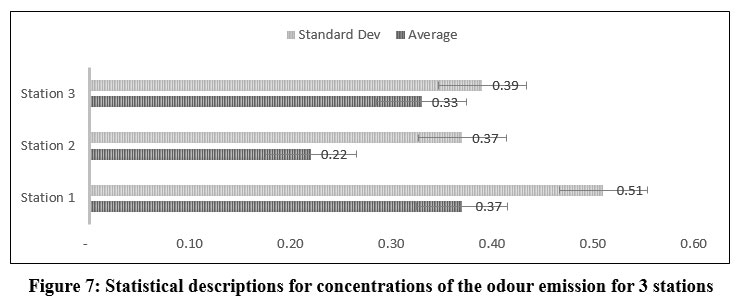 | Figure 7: Statistical descriptions for concentrations of the odour emission for 3 stations
|
Comparison of detected VOCs with HAPs
During odour emission monitoring on fresh waste at the MSWDY, around fourteen various odorous compounds were identified with different concentration levels at the dumping yards. To identify the detected compounds areas carcinogenic or non-carcinogenic,disease with US-EPA hazardous air pollutants(HAPs) isare shown in the table: 4 Nine different VOCs can possibly cause carcinogenic problemscancer to the surrounding environments, and five VOCs are non-carcinogenic compounds. ,also calledFurthermore, as noncommunicable diseases (NCDs) causing substances, VOCs can cause allergies, headaches, eye irritation and nausea as well as harm the human respiratory system.16 A major source of air pollution in our surroundings stems from mono-aromatic compounds. These substances, which include benzene, toluene, ethylbenzene, and xylene, can be divided into two categories: those that may cause cancer and those that do not. Their presence significantly impacts the quality of ambient air.17 The classification of BTEX compounds as hazardous air pollutants is well-established. The International Agency for Research on Cancer (IARC) has evaluated these substances, assigning benzene to Group 1, which denotes confirmed human carcinogens. Ethylbenzene has been placed in Group 2B, indicating potential carcinogenicity to humans. In contrast, toluene and xylenes are categorized as Group 3, signifying that their carcinogenic effects on humans cannot be definitively determined based on current evidence.18
Table 4: List of Carcinogenic Vs Non-Carcinogenic VOCs Compounds
S.No | VOCs Compounds | CAS Number | Carcinogenic or Non-Carcinogenic Diseases |
1 | Toluene | 108883 | Carcinogenic |
2 | Benzene | 71432 | |
3 | o -xylenes | 95476 | |
4 | p-xylenes | 106423 | |
5 | m-xylenes | 108383 | |
6 | Chlorobenzene | 108907 | |
7 | Ethyl benzene | 100414 | |
8 | Methyl chloride | 74873 | |
9 | Tetrachloroethylene | 127184 | |
10 | Sec- butylbenzene | 135988 | Non-Carcinogenic |
11 | tert – butylbenzene | 98066 | |
12 | Methyl ethyl ketone | 78933 | |
13 | n-butylbenzene | 104518 | |
14 | Trichloro fluro methane | 75694 |
Consequence of Odour Exposure for Public Health
Research on the harmful impacts of odoriferous compounds aims to assess the consequences of varying odour intensities. The primary way that humans are exposed to volatile organic compounds from MSW dumping yards is through inhalation (nose, mouth, and skin). As a result, people may have a range of health issues, including minor respiratory conditions including coughs, wheezes, allergies, and asthma. People who live near the landfill may observe an increase in air pollution, noise, traffic, and odour. 6 MSW dumping yard contains a number of volatile organic compounds (VOCs), including xylene (m&p,o), which are harmful to human health. Their skin, mouth, and eyes may come into contact with the material.19 Low levels of xylene (< 200 ppm) exposure can create short-term negative effects that are harmful to the skin and the respiratory system. From stations 1 & 2 the hourly monitored value of m&p,o xylene was± 0.25 ppm. The intermediate product is formed by the reaction of benzene with carbohydrate discharged, tert-butylbenzene into the MSW disposal yard, can cause eye irritation from tert-butylbenzene present in the MSWDYs.20 There were frequent complaints of headaches, sleepiness, eyesores, and nose irritation among sensitive exposure victims14
Odour Exposure for Workers - Skin
Segregating waste in the collection area of waste is one of the many ways municipal solid waste handling area personnel handle wastes on a regular basis. On the other hand, street sweepers breathe in different gases through their noses and mouths. Additionally, these molecules affecting the human body, especially those volatile organic compounds, which can enter through the skin causing skin and other problems for the workers.
The skin is crucial to the human body because it allows different gaseous substances, such as volatile organic compounds (VOCs), to enter the body when waste is being handled at a landfill. Through the worker's skin's transcutaneous and systemic pathways, the gases (VOCs) enter the superficial and deeper layers of the skin.21
Odour Exposure for Workers – Eyes
Tert-butylbenzene is a chemical compound that belongs to the family of aromatic hydrocarbon. A carbohydrate is created when isobutene and lewis acid react. Benzene then reacts with carbohydrate to generate an intermediate product, which causes tert-butylbenzene to be released into the MSW disposal yard. The MSW Dumping Yard contains tert-butylbenzene, which can irritate workers' eyes.22 MSW workers who frequently work in dumping yards might get blepharitis and inflamed eyes.
Consequence of Odour Exposure for Vacant Lands
Most of the MSWDYs are near agricultural or vacant lands due to disposal of MSW it can affect the properties of soil. In the MSW, various chemical compounds take place during the decomposition process and microbial activity. During that time, chemicals easily penetrate inside the land surface, making it possible to have an impact on the soil's properties.11 Greenhouse gas emissions, including volatile organic compounds (VOCs), carbon dioxide (CO2), methane (CH4), and nitrous oxide (N2O), are affected by the actions of microorganisms. To evaluate their effect on global climate patterns, it is essential to comprehend the roles that microbes play in these odour emission processes also.23
Consequence of Odour Exposure for Quality of Life
Most of the MSWDYs are located in both urban and semi urban areas. Due to urbanization and developmentof housing colonies, zoning activity takes place near MSWDYs, and odour emissions easily affect property value and the quality of life of the residents. Odour emissions have consequences for the whole environment, causing air and water pollution. Odour emission easily penetrated into the ground, and it impact the soil properties.20 Odour nuisance, which is the term for air pollution caused by odours, is especially unpleasant for people who live close to MSW dumping yard. However, residing in an area with offensive odours has an impact on daily life and leads to subjective perceptions of one's health.24
Consequence of Odour Exposure for Infrastructures
In the surroundings of MSWDYs these days, a lot of commercial and residential buildings are located. Due to the dumping of different kinds of waste, a lot of gaseous pollutants get generated in the MSWDYs. The pollutants like methane, hydrogen sulfide, VOCs, mercaptans, etc. are the main cause of odour emissions, which predominantly impact the residents. Table 3 presents the 0.23 µg/m3 chlorofluorocarbon level and its sweet-smelling odour emission at specific temperatures from MSWDYs. The presence of CFCs, which has the potential to cause global warming, does not directly destroy building and transportation materials, but it does indirectly affect the balance of radiation on the surface of the earth.25 The odour is one of the main things that the locals are concerned about around the landfill.26
Conclusion
The escalating odour emissions from Municipal Solid Waste Disposal Yards (MSWDYs) represent a pressing concern across local, national, and global levels. This study's findings indicate that odour emission samples from Municipal Solid Waste (MSW) were obtained at three distinct sites within MSWDY perimeters to quantify the concentration of odour-causing volatile organic compounds (VOCs). The investigation carried out using GC-MS 6280N determined the identity of the odour emissions. For the sampling, three different locations were chosen in the MSWDYs. Comparison of various odours compounds and concentrations at three stations, volatile organic compound (VOC) concentrations revealed that stations 1 to 3, which are of fresh municipal solid waste at the dumping yards, had higher overall VOC concentrations. The sampling location 1 dumping yard yielded a value of 1.41 µg/m3, which is the maximum VOC concentration of tert-butylbenzene. At sampling station 2, the lowest VOC concentration of 0.07 µg/m3 was found (sec-butylbenzene). Simultaneously compared with stations 1, 2, and 3, station 1 has a descriptive statistics average of 0.37 and a standard deviation of 0.51. The presence of aromatic compounds takes a major role in station 1. Additionally, it was shown that weather conditions had a substantial impact on the concentration of odours on MSWDYs. Along with Thiruporur's population growth, the amount of MSW generated has increased significantly. Among other issues, inadequate collection coverage, irregular collection services, open dumping, burning, and other problems increase in odour emissions and environmental nuisance. In addition, the health of those working in the dumping yard is at risk from carcinogenic and noncarcinogenic odour emissions from the MSWDYs. Thus, it necessitates regular health monitoring of dump yard workers in addition to proper management of municipal waste. Mitigation for reducing consequence of odour exposure for the current scenario these findings highlight the need of controlling odour emissions (VOCs) from solid waste disposal in MSWDYs. Wet and dry waste should be separated during the collection system and strictly followed to being transferred to MSWDYs separately. Due to inadequate separation of waste at source, inappropriate collection and transportation, all types of waste are mixed together, creating bad and harmful odour emissions. These findings will help create awareness regarding the necessity for achieving greater compliance with the SWM Rules and reduce their detrimental effects on the environment and the public's health. The processing of segregated wet waste that takes place in the composting or biogas facilities preventing its dumping in the MSWDYs would help control itodour along with other mechanisms using chemical and biological odour control substances.
Acknowledgement
The authors are obliged to Aarupadai Veedu Institute of Technology (AVIT), Vinayaka Mission’s Research Foundation (VMRF) Paiyanoor Chennai-603 104 for providing laboratory facilities and carried out the research work Odour Emission.
Funding Sources
The author(s) received no financial support for the research, authorship, and/or publication of this article.
Conflict of Interest
The author(s) declares no conflict of interest.
Ethics Statement
This research did not involve human participants, animal subjects, or any material that requires ethical approval.
Informed Consent Statement
This study did not involve human participants, and therefore, informed consent was not required.
Data Availability Statement
This statement does not apply to this article
Authors’ Contribution
Dr.R.Divahar : Visualization, Supervision, Project Administration.
S.Srinivasan : Conceptualization, Methodology, Writing – Original Draft , Data Collection, Analysis, Writing – Review & Editing.
References
- World Bank Group Solid waste management, World Bank. https://www.worldbank.org/en/topic/urbandevelopment/brief/solid-waste-management (2023).
- Jayasinghe, P.A., Jalilzadeh, H. and Hettiaratchi, P. (2023) ‘The impact of covid-19 on waste infrastructure: Lessons learned and opportunities for a sustainable future’, International Journal of Environmental Research and Public Health, 20(5), p. 4310. doi:10.3390/ijerph20054310.
CrossRef - Joshi, R, Ahmed, S. Status and challenges of municipal solid waste management in India: A review. Cogent environmental science, 2016; 2(1):1139434.
CrossRef - Dlamini, B. Evaluating the performance (effectiveness and efficiency) of waste management and minimization practices in the district municipalities (Umkhanyakude and Zululand) in the KwaZuluNatal Province, South Africa. 2019;3
- Ahluwalia, I.J, Patel, U. Solid Waste Management in India An Assessment of Resource Recovery and Environmental Impact Isher Judge Ahluwalia. Indian Council for Research on International Economic Relations (ICRIER), New Delhi. 2018; 356. https://hdl.handle.net/10419/203690.
- Sharma, G., & Sinha, B. (2023). Future emissions of greenhouse gases, particulate matter and volatile organic compounds from municipal solid waste burning in India. Science of The Total Environment, 858, 159708.https://doi.org/10.1016/j.scitotenv.2022.159708.
CrossRef - Sharma, B., Mehta, P., & Verma, P. A Study on Physical Characterization of Municipal Solid Waste of Jammu City on the basis of Socioeconomic Status of the Population. Current World Environment0973-4929, Vol. 18, No. (3) 2023, Pg. 1370-1383. Doi: https://dx.doi.org/10.12944/CWE.18.3.36.
CrossRef - Kjeldsen P., Morton A., Alix P., Anders B., Anna Ledin., Christensen H., ‘Present and long-term composition of MSW Landfill Leachate: A Review’, Critical Reviews in Environmental Science and Technology, 2002 32(4), pp. 297–336. doi:10.1080/10643380290813462.
CrossRef - Chen, X., Guo, J., Xie, G. J., Liu, Y., Yuan, Z., Ni, B. J. A new approach to simultaneous ammonium and dissolved methane removal from anaerobic digestion liquor: a model-based investigation of feasibility. Water Research, 2015; 85, 295-303.
CrossRef - Butt, T. E., Javadi, A. A., Nunns, M. A., & Beal, C. D. (2016). Development of a conceptual framework of holistic risk assessment—Landfill as a particular type of contaminated land. Science of the Total Environment, 569, 815-829.
CrossRef - Khanna, S., Chauhan, S. (2023). Environmental Impacts and Mitigation Strategies of the Current Landfill Site in Gurugram, Haryana. Current World Environment, 18(1), 350. Doi: http://dx.doi.org/10.12944/CWE.18.1.29.
CrossRef - Shao, Y., Xia, M., Liu, J., Liu, X., Li, Z. Composition and profiles of volatile organic compounds during waste decomposition by the anaerobic bacteria purified from landfill. Waste Management, 2021; 126, 466-475.
CrossRef - Kumarathilaka, Prasanna,Yohan Jayawardhana, ‘Characterizing volatile organic compounds in leachate from Gohagoda municipal solid waste dumpsite, Sri Lanka’, Groundwater for Sustainable Development, 2016; 2–3,1–6. doi: 10.1016/j.gsd.2016.04.001.
CrossRef - Young, P. J., and Parker, A. “The identification and possible environmental impact of trace gases and vapor in landfill gas.” Waste Management. Recourses.1983; 1, 213–226.
CrossRef - Al Naim, A. S., &Alomair, A. (2024). Board Composition and Environmental, Social, and Governance Reporting: Impact of Foreign and Busy Directors in Saudi-Listed Firms. Sustainability, 16(20), 8985.
- EPA. https://www.epa.gov/haps/health-and-environmental-effects-hazardous-air-pollutants (Accessed: 03 January 2025) .
CrossRef - Abbasi, F., Pasalari, H., Delgado-Saborit, J. M., Rafiee, A., Abbasi, A., &Hoseini, M. (2020). Characterization and risk assessment of BTEX in ambient air of a Middle Eastern City. Process Safety and Environmental Protection, 139, 98-105.
CrossRef - Rafiee, A., Delgado-Saborit, J. M., Sly, P. D., Amiri, H., &Hoseini, M. (2019). Lifestyle and occupational factors affecting exposure to BTEX in municipal solid waste composting facility workers. Science of the Total Environment, 656, 540-546. http://dx.doi.org/10. 1016/j.scitotenv.2018.11.398.
CrossRef - Langman M. "Xylene: its toxicity, measurement of exposure levels, absorption, metabolism and clearance." Pathology,1994; 26.3; 301-309.
CrossRef - Blair, A., Hartage P., Stewart PA., McAdams M., Lubin J Mortality and cancer incidence of aircraft maintenance workers exposed to trichloroethylene and other organic solvents and chemicals. Occupational and Environmental Medicine,1998 ;55(3), 161–171. doi:10.1136/oem.55.3.161.
CrossRef - Araviiskaia, E., Berardesca, E., Bieber, T., Gontijo, G., Sanchez Viera, M., Marrot, L., &Dreno, B. (2019). The impact of airborne pollution on skin. Journal of the European Academy of Dermatology and Venereology, 33(8), 1496-1505.DOI: 10.1111/jdv.15583
CrossRef - Ismail, Lukman, Zaini Sakawi, and Mohamad Khalil Saipi. "Measurement of Odour Concentration from Livestock Farm." Current World Environment 9.2 (2014): 264 http://dx.doi.org/10.12944/CWE.9.2.06.
CrossRef - Surendra Singh Bargal Soil Microbial Biomass: A Crucial Indicator of Soil Health, Current Agriculture Research Journal, 2024; 2347-4688, 12,(1) 01-06.
CrossRef - Wang, Y., Li, L., Qiu, Z., Yang, K., Han, Y., Chai, F., Wang, Y. Trace volatile compounds in the air of domestic waste landfill site: Identification, olfactory effect and cancer risk. Chemosphere,2021; 272, 129582.
CrossRef - Wojnarowska, M., Plichta, G., Sagan, A., Plichta, J., Stobiecka, J., &So?tysik, M. (2020). Odour nuisance and urban residents' quality of life: A case study in Kraków's in Plaszow district. Urban Climate, 34, 100704. https://doi.org/10.1016/j.uclim.2020.100704.
CrossRef - Chai, F., Li, P., Li, L., Qiu, Z., Han, Y., & Yang, K. (2022). Dispersion, olfactory effect, and health risks of VOCs and odors in a rural domestic waste transfer station. Environmental Research, 209, 112879.
CrossRef







